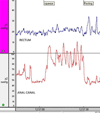ANMS-ESNM position paper and consensus guidelines on biofeedback therapy for anorectal disorders
- PMID: 25828100
- PMCID: PMC4409469
- DOI: 10.1111/nmo.12520
ANMS-ESNM position paper and consensus guidelines on biofeedback therapy for anorectal disorders
Abstract
Background: Anorectal disorders such as dyssynergic defecation, fecal incontinence, levator ani syndrome, and solitary rectal ulcer syndrome are common, and affect both the adult and pediatric populations. Although they are treated with several treatment approaches, over the last two decades, biofeedback therapy using visual and verbal feedback techniques has emerged as an useful option. Because it is safe, it is commonly recommended. However, the clinical efficacy of biofeedback therapy in adults and children is not clearly known, and there is a lack of critical appraisal of the techniques used and the outcomes of biofeedback therapy for these disorders.
Purpose: The American Neurogastroenterology and Motility Society and the European Society of Neurogastroenterology and Motility convened a task force to examine the indications, study performance characteristics, methodologies used, and the efficacy of biofeedback therapy, and to provide evidence-based recommendations. Based on the strength of evidence, biofeedback therapy is recommended for the short-term and long-term treatment of constipation with dyssynergic defecation (Level I, Grade A), and for the treatment of fecal incontinence (Level II, Grade B). Biofeedback therapy may be useful in the short-term treatment of Levator Ani Syndrome with dyssynergic defecation (Level II, Grade B), and solitary rectal ulcer syndrome with dyssynergic defecation (Level III, Grade C), but the evidence is fair. Evidence does not support the use of biofeedback for the treatment of childhood constipation (Level 1, Grade D).
Keywords: biofeedback therapy; constipation; dyssynergic defecation; fecal incontinence; levator ani syndrome.
© 2015 John Wiley & Sons Ltd.
Conflict of interest statement
Figures


References
-
- Wald AB, Bharucha A, Cosman BC, et al. ACG clinical guidelines: management of benign anorectal disorders. Am J Gastroenterol. 2014 (in press) - PubMed
-
- Mugie SM, Di LC, Benninga MA. Constipation in childhood. Nat Rev Gastroenterol Hepatol. 2011;8:502–511. - PubMed
-
- Whitehead WE, Rao SS, Lowry A, et al. Treatment of fecal incontinence: State of the Science and directions for future research. Am J Gastroenterol. 2015 (in press) - PubMed
-
- Harris RP, Helfand M, Woolf SH, et al. Current methods of the US Preventive Services Task Force: a review of the process. Am J Prev Med. 2001;20:21–35. - PubMed
Publication types
MeSH terms
Supplementary concepts
Grants and funding
LinkOut - more resources
Full Text Sources
Other Literature Sources
Medical

